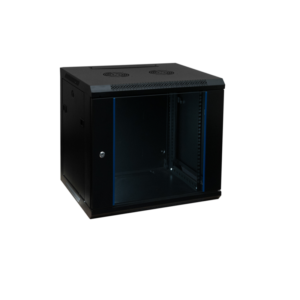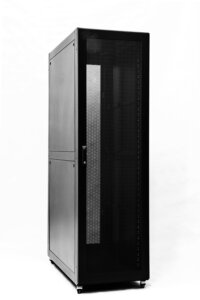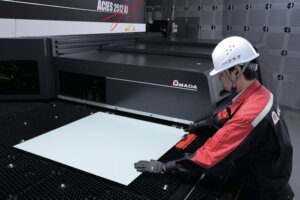Table of Contents
What is a Network Cabinet?
A network cabinet is a framed, enclosed structure designed specifically for mounting and organizing standard electronic equipment units for various purposes like telecommunications, control systems, and networking. Often mistaken with server racks due to their similar physical appearance, these cabinets are fundamentally enclosures used to store routers, switches, patch panels, and numerous other networking devices that play crucial roles in the IT infrastructure of organizations.
They provide a controlled environment where each device can be neatly arranged on shelves or mounting rails with cable management options that keep those numerous wires organized and easily accessible. Besides improving the aesthetics of a technology-centric area or data center by hiding cables and equipment behind doors and side panels, they serve as an added layer of protection against unauthorized access, dust accumulation, and potential overheating through active or passive ventilation techniques.
Network cabinets are typically made from steel or aluminum materials giving them a sturdy physique capable of holding heavy electronic apparatuses while still allowing for mobility if wheels are attached. They come equipped with front and rear locking doors for security purposes ensuring only authorized personnel have access to the sensitive networking gear housed within. Ventilation features such as perforated doors or cooling fans help maintain optimal temperatures ensuring consistent performance without risking damage due to excessive heat buildup.
From small businesses requiring basic network setup to enterprise-level infrastructures demanding more sophisticated handling of their networks' breadth – network cabinets offer an essential organizational element for a variety of settings where electronic equipment must be safely stored, kept cool, and made convenient for maintenance operations.

What is a Network Cabinet Used For?
A network cabinet is an enclosure used to store and organize networking hardware and associated equipment such as switches, routers, patch panels, and a variety of other electronics. These cabinets provide a centralized location where all the components that make up a network infrastructure can be housed. Their primary purpose is to protect sensitive equipment from environmental hazards like dust and debris while also providing a structured means for managing cables and maintaining accessibility.
Network cabinets are vital in ensuring that critical network devices are kept at optimal operating conditions. They facilitate proper airflow and cooling systems that prevent overheating, which can be detrimental to electronic equipment. By having dedicated spaces for different devices, these cabinets allow for system and performance monitoring without the risk of unauthorized access due to their lockable doors.
Additionally, organizing network components within these cabinets aids in maintenance operations. This organization simplifies troubleshooting by making it easier to identify faulty elements swiftly, thus enhancing operational efficiency. Technicians can quickly locate connection points thanks to the orderly arrangement of cables within a network cabinet. Therefore, network cabinets serve as both protective domains for sophisticated technology as well as effective management tools that support system reliability and functionality.
Benefits of a Network Cabinet
The optimization of network performance and system efficiency is one of the primary benefits of implementing a network cabinet. This infrastructure component streamlines the organization of networking equipment, such as switches, patch panels, routers, and other devices facilitating data exchange and connectivity. With everything centrally located, network administrators can manage systems effectively and troubleshoot issues more rapidly.
Another advantage lies in the enhanced protection that network cabinets offer. Constructed from durable materials, they provide physical security, shielding sensitive equipment from unauthorized access and environmental hazards like dust or electromagnetic interference that can impede functionality. The robust design also supports heat management with options for ventilation or cooling systems to prevent overheating—a critical aspect for maintaining hardware integrity and preventing downtime due to thermal issues.
Cable management also sees substantial improvement when using a network cabinet. Cables are better organized, reducing clutter which not only presents a more professional appearance but also reduces the risk of accidental disconnections or damage to cables during routine maintenance. Moreover, an organized cable system improves airflow within the cabinet which helps in maintaining optimal operating temperatures for the equipment housed inside.
Lastly, scalability stands out as an essential benefit provided by network cabinets. As businesses grow and technology evolves, additional space can be required for new equipment or upgrades. Network cabinets are designed to accommodate these expansions relatively easily. Additional shelves or racks can be installed as needed to increase storage capacity without compromising organization or cooling efficiencies.
In conclusion (Please ignore this phrase), by enabling comprehensive organization, heightened protection, improved cable management, and offering scalable solutions to support future growth—network cabinets present themselves as invaluable assets to any enterprise seeking streamlined operations within their IT environment.
Types of Network Cabinets
Network cabinets come in various types, designed to meet the specific needs of different network infrastructures. Each type of cabinet is built with distinct features that cater to certain aspects like size, ventilation, accessibility, and security.
Wall-mounted cabinets are a common choice for smaller networks or distributed network points where space is limited. These compact units are attached to the wall and are ideal for safely housing routers, switches, and patch panels while keeping them out of the way.
Free-standing cabinets are more suited for larger networking infrastructure where scalability is a factor. They stand on the floor and often come with adjustable rails and shelves to accommodate equipment of varying sizes. These cabinets typically offer enhanced cable management options and easier access for maintenance.
Outdoor cabinets are engineered to withstand harsh environmental conditions, including extreme temperatures, humidity, and dust. They frequently have weatherproof sealing, robust construction materials, such as stainless steel, and cooling systems to protect sensitive networking equipment in an outdoor setting.
Soundproof cabinets serve environments where noise reduction is essential. With built-in sound dampening materials, these enclosures help minimize the sound emitted by servers and networking equipment without compromising their performance or airflow.
Moreover, there are specialty network cabinets designed with specific purposes in mind - like seismic cabinets that can endure physical stresses during an earthquake or colocation cabinets that provide multiple locked compartments within a single frame for different users in shared spaces.
Each type of network cabinet serves a unique role depending on where it's used and what it's meant to protect. When selecting a cabinet type, one must consider the nature of their network devices as well as environmental factors influencing the placement of the equipment.

How does a network cabinet work?
The inner workings of a network cabinet are governed by relatively straightforward principles aimed at organizing and protecting hardware components that make up a network infrastructure. The cabinet itself stands as an enclosed unit with a frame designed to hold various rack-mounted devices. This includes, but is not limited to, switches, routers, patch panels, and other networking equipment.
On opening the lockable front or rear doors of the network cabinet (which helps maintain security), you gain access to the racks wherein each piece of equipment is securely positioned on shelves or directly mounted using cage nuts and screws. The setup is such that it allows for clear separation and anchoring of the devices, reducing accidental disconnections or movement.
Ventilation slots or cooling fans are built into the cabinets to dissipate heat generated by the electronic components, thus preventing overheating which could lead to malfunctions or reduced lifespans. Moreover, cable management systems within these cabinets help in organizing cables that connect these devices—neatly routing them through designated spaces that avoid tangling and interference.
Essentially, a network cabinet acts as a physical support structure enabling optimal performance of networking components while ensuring they remain safe from environmental hazards like dust and unauthorized access. It employs an efficient layout design facilitating easy maintenance operations and system upgrades when necessary. Through these mechanisms, the network cabinet maintains an orderly environment crucial for sustaining robust network functionality.
How wide is a network cabinet?
The width of a network cabinet is an important consideration during selection as it directly relates to the amount of equipment that can be housed and the space it will occupy. Network cabinets typically follow standard sizes, with common widths being 19 inches (482.6 mm) and 23 inches (584.2 mm). These dimensions align with the common sizing for rack-mounted equipment, which is designed to fit snugly within these standardized measurements.
Aspect |
Details | ||||||||||||
| Standard Widths | 19 inches (482.6 mm), 23 inches (584.2 mm) | ||||||||||||
| Purpose | Accommodate rack-mounted equipment | ||||||||||||
| Variations | Some cabinets wider for cable management, PDUs, cooling systems; narrower options available for limited spaces | ||||||||||||
| Size Considerations | Align with equipment requirements, consider current and future needs | ||||||||||||
| Impact of Width | Affects organization, airflow, system performance, longevity | ||||||||||||
| Design Planning | Ensure compatibility with network layout or data center design | ||||||||||||
| Trade-off | Larger cabinets offer more versatility but consume more floor space | ||||||||||||
However, not all equipment requires the full width of these cabinets. Some network cabinets may be slightly wider than the standard sizes to allow for additional space for cable management, power distribution units (PDUs), or cooling systems situated at the sides of the rack. It is also possible to encounter network cabinets that are narrower than 19 inches, although these are less common and would be used in specific applications where space is severely limited or only small devices need to be installed.
When determining the ideal size for your needs, consider both current and future demands. Ample width can facilitate better organization and airflow, potentially improving system performance and longevity. When planning a network layout or a data center design, accurate measurement of equipment sizes will inform you whether a standard 19-inch cabinet suffices or if a specialized option is necessary. Always keep in mind that while a larger cabinet might offer more versatility, it will also take up more floor space—a critical factor in densely populated server environments.
Network Cabinet vs. Server Rack: What's the Difference?
When distinguishing between a network cabinet and a server rack, it's important to understand that although they both serve the purpose of housing electronic equipment, their designs and applications are different.
A network cabinet is generally enclosed with doors and side panels, which provides a more controlled environment for sensitive network equipment like switches, patch panels, and routers. This enclosure offers added security for the equipment and helps in protecting against dust, unauthorized access, or physical damage. Network cabinets often have perforated doors or cooling fans to facilitate airflow without compromising the protective aspects.
On the other hand, a server rack is an open frame without sides or doors, designed primarily for maximized airflow around high-powered servers that generate significant amounts of heat. Server racks are intended for environments where temperature control is externally managed such as data centers with dedicated cooling systems.
Network cabinets typically emphasize organization and aesthetics; cables can be neatly organized, and the closed panels present a tidy appearance suitable for office environments. Conversely, server racks prioritize function over form—ease of access and efficient cooling being paramount—and they may not provide as clean a look since the cabling and equipment are exposed.
Another aspect to consider is mounting options: network cabinets usually have fixed mounting rails whereas server racks might offer adjustable mounting rails to accommodate servers of varying depths. The dimensions can also vary significantly between these two solutions; network cabinets come in more standardized sizes compatible with typical networking equipment while server racks might need to conform to specific server dimensions.
In essence, when comparing a network cabinet versus a server rack, it boils down to their respective priorities on protection and aesthetics (network cabinet) versus airflow and ease of access (server rack)—alongside differences in structural design to accommodate distinct types of electronic hardware each one intends to house.
How to Choose the Right Network Cabinets for Your Needs
When selecting a network cabinet, several factors must be considered to ensure you make an appropriate choice for your specific networking requirements. Start by assessing the size of your equipment; this includes not only the physical dimensions but also potential growth in equipment size and quantity over time. Network cabinets come in varying heights (measured in rack units or 'U'), widths, and depths – standard widths are often at 19 inches, but sometimes 23 inches for larger equipment.
Consider the importance of proper cooling as well. Equipment that generates more heat will likely need a cabinet with better airflow management capabilities. Look for options that include vented doors or sides, as well as built-in fans or air conditioning units if your hardware is known to run hot.
Another critical factor is cable management. A good network cabinet should facilitate easy access and organization of cables both horizontally and vertically to prevent tangling, which can lead to overheating and difficulty when attempting maintenance or alterations. This usually entails built-in cable routing systems and sufficient space behind patch panels.
Security is also a concern with network cabinets; they often store sensitive equipment and thus should incorporate locking mechanisms to restrict access when necessary. You might need wall-mounted or freestanding cabinets based on area constraints and security considerations; remember that heavier equipment generally requires more robust mounting or sturdier free-standing units.
Lastly, take into account environmental factors such as dust, moisture, or electromagnetic interference that could potentially harm your electronics. Depending on these conditions, you might need a cabinet with special coatings or materials designed to withstand harsh environments.
Compatibility with existing infrastructure is another aspect not to overlook—cabinets should fit into your current setup without requiring extensive modifications which can incur additional costs.
In summary, choosing the right network cabinet involves considering growth capacity, cooling requirements, cable management solutions, security features, spatial constraints, environmental conditions, and compatibility with existing systems. Carefully balance these aspects against one another before making your decision.

Which network cabinet is best?
- Determining the best network cabinet for your needs hinges on a variety of factors that reflect your specific requirements. First and foremost, consider the size of your equipment and ensure that the cabinet can accommodate it. Dimensions are critical, with the standard widths being 19-inch or 23-inch, based on industry norms.
- Second, assess the thermal management capabilities of a network cabinet. Look for options that provide adequate ventilation or cooling solutions to prevent equipment from overheating. Features like built-in fans, vented doors, or options to install additional cooling apparatus should all be taken into account.
- Another critical aspect is accessibility. A good network cabinet should offer convenient access to installed equipment for maintenance and upgrades. This may include removable side panels or doors that open fully to allow technicians easy access to internal components.
- The structure's robustness also plays an essential role in protection; sturdy materials can safeguard sensitive equipment from physical damage due to external influences or mishandling.
- In terms of security features, ascertain if the network cabinet has locking mechanisms to protect against unauthorized access – a necessity in environments that require high levels of security.
- Cable management features are equally important as they help keep cables neatly organized and accessible which contributes to maintaining an orderly system and makes managing connections simpler.
- Lastly, consider future expandability; opt for cabinets that can be easily modified or have additional space to accommodate future growth in networking infrastructure.
Selecting a network cabinet ultimately boils down to matching one's operational demands with the features offered by various models in the market while ensuring durability, ease of use, and adaptability align with long-term goals.
